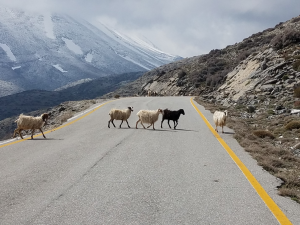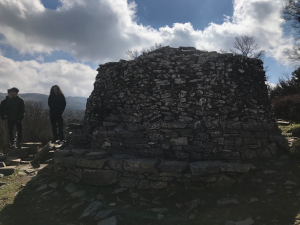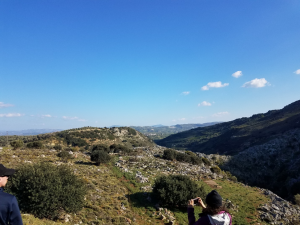On our second day in Crete, we drove into the mountains around Psiloritis.
The Cretan detachment fault exposed under a highway bridge. Shear zones from an old thrust fault, shearing toward the north. The contact was reactivated in the late Miocene as a normal fault shearing toward the south. 2 euro coin for scale.
Almyros spring, the largest spring in Crete, is a brackish karstic spring. Water from the Tripolitsa unit and the Psiloritis Mountains travels the 25 km to the spring in just 9 hours. Another system brings sea water into the cave system, hence the brackish composition. Water flow in spring, when the water is fresh, is enough to supply ¼ of the island’s demand, but there’s nowhere to store it year-round.
Voulismeno Aloni Pothole. A karstic depression in Tripolitsa limestone. This was a cave once, but the roof collapsed leaving an impressive circular hole. This feature is connected to the Almyros spring.
Massive marble below, part of the Plattenkalk Unit, upper Triassic to lower Jurassic in age. Plated marble above, upper Jurassic to Oligocene in age.
Impressive folds at Vossakos, in platy marbles of the Plattenkalk unit. Axial plane dips to the north. Folding is from the Oligocene due to early subduction processes. The thin white layers are silica.
Boudinage in Vossakos. This indicates the sense of deformation.
We stopped for lunch at the Psiloritis geo-park in Anogeia. There are no traditional buildings left in the town, because the Germans destroyed it during World War II.
On the way to our next stop at Nida Plateau, these goats didn’t wait for our bus. This was a common occurrence in the mountains. In the background is Psiloritis.
The view from Nida Plateau. The shadowy line just below the clouds on the right is the Cretan Detachment on Psiloritis.
Agios Fanourios detachment fault. Tripolitsa rests on top of Plattenkalk metaflysch. The Tripolitsa rocks hold plenty of water (feeding the Almyros spring) which seeps out of the detachment in some places.
A mitato, a seasonal shepard’s residence. These structures don’t utilize mud or any other binding agent. Large stones are stacked in a way that provides a dry interior even in rain. Behind this building is a smaller mitato used to store and mature cheese.
Our last stop was the ophiolite at Gonies, a piece of serpentinized oceanic mantle that is the uppermost nappe of Crete. A 1 km line starting here crosses all the major units of Crete, but (even though it’s the same units) doing the same thing in northern Greece would take over 100 km!
Looking the other way from Gonies. This gorge is the longest in the Psiloritis area, but part of it is in the Heraklion basin and relatively flat. In the distance, we could see the normal faults bounding the Heraklion basin.
-Tyler and Bart











